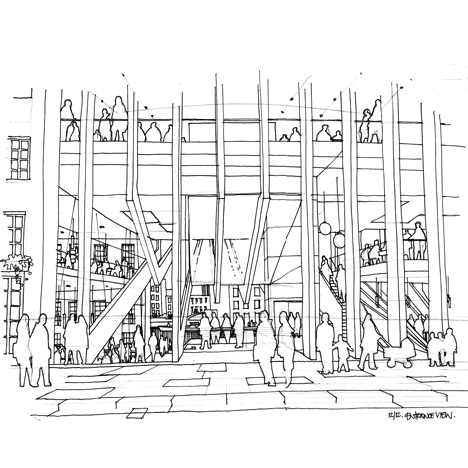 British studio Fletcher Crane Architects have won a competition to design a waterside office building on the river Aire in Leeds, UK.
British studio Fletcher Crane Architects have won a competition to design a waterside office building on the river Aire in Leeds, UK. 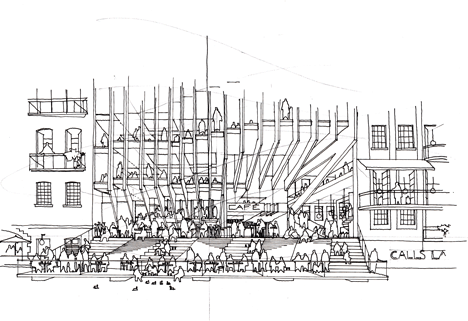 Click for larger image The new building at 36 The Calls will also act as a support hub for small local businesses, offering business facilities and meeting places.
Click for larger image The new building at 36 The Calls will also act as a support hub for small local businesses, offering business facilities and meeting places. 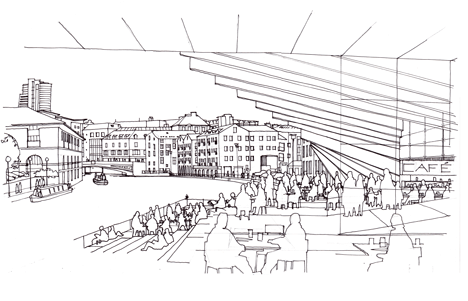 Click for larger image Fins covering the facade will create the impression of a solid block when viewed along the narrow street, in keeping with the surrounding industrial buildings, but open up to the river from inside.
Click for larger image Fins covering the facade will create the impression of a solid block when viewed along the narrow street, in keeping with the surrounding industrial buildings, but open up to the river from inside. 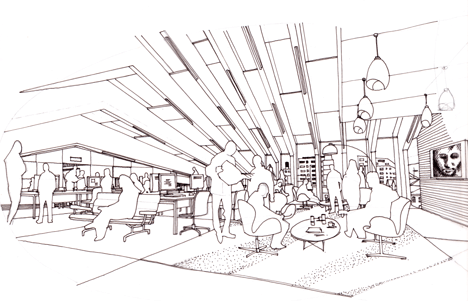 Click for larger image Incorporating the adjacent existing building 38 The Calls, the site will step down from the street side allowing for cafes and meeting areas by the water’s edge.
Click for larger image Incorporating the adjacent existing building 38 The Calls, the site will step down from the street side allowing for cafes and meeting areas by the water’s edge. 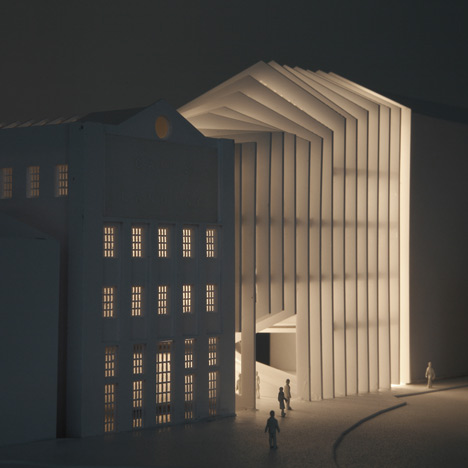 See also: Entry for 36 The Calls by Davide Marchetti Architetto (February 2010)
See also: Entry for 36 The Calls by Davide Marchetti Architetto (February 2010) 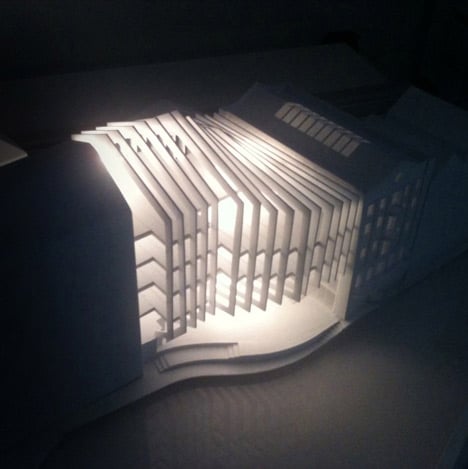 Here’s some more information from Fletcher Crane Architects:
Here’s some more information from Fletcher Crane Architects:
Introduction
- ‘The Loom’ is the apparatus for weaving strands of local business into a collective.
- Unique and distinctive building.
- Integrated, innovative structural solution and sculptural form.
- Using local context as building generator.
- Glorification of post-industrial buildings.
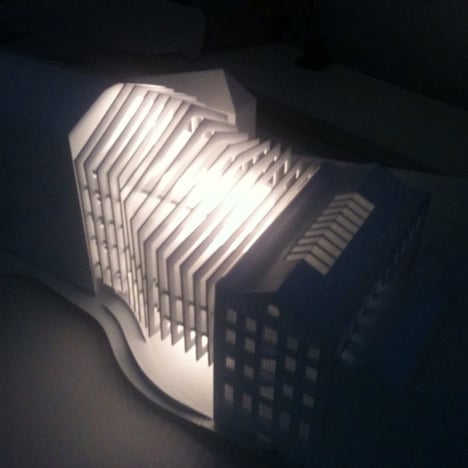 Commentary The design approach will enable the scheme to have iconic status both locally and throughout Yorkshire giving local business’ a wider presence throughout the region. The proposed waterfront cafe on site, along with the retention of the existing restaurant will complement the business hub providing an alternative venue for meeting, networking and relaxing. Opening up the water front will provide a destination and meeting place for Leeds, attracting people to the area and facilitating exposure for the local business’.
Commentary The design approach will enable the scheme to have iconic status both locally and throughout Yorkshire giving local business’ a wider presence throughout the region. The proposed waterfront cafe on site, along with the retention of the existing restaurant will complement the business hub providing an alternative venue for meeting, networking and relaxing. Opening up the water front will provide a destination and meeting place for Leeds, attracting people to the area and facilitating exposure for the local business’. 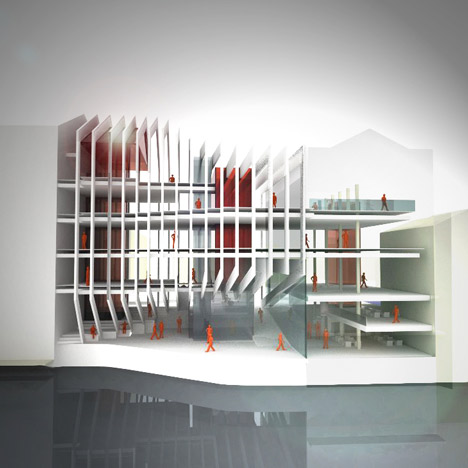 The initial brief called for an iconic building, and delivering a commercially viable scheme that was able to meet that criteria whilst responding to the city urban design agenda, historic context presented a great challenge. The proposed scheme has been carefully developed to be appropriate to the site, but also be uniquely crafted, providing a presence at local, regional and national level.
The initial brief called for an iconic building, and delivering a commercially viable scheme that was able to meet that criteria whilst responding to the city urban design agenda, historic context presented a great challenge. The proposed scheme has been carefully developed to be appropriate to the site, but also be uniquely crafted, providing a presence at local, regional and national level. 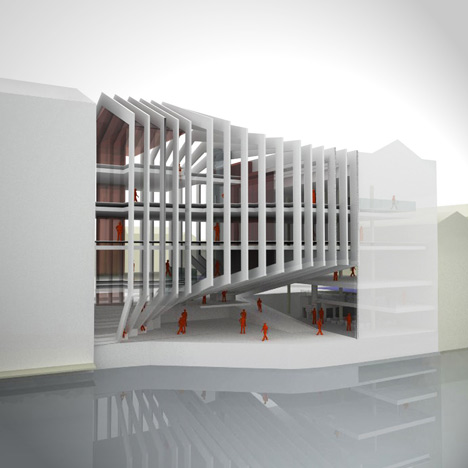 The proposals look to marry the external architecture with that of the interior environment, making the most of the fantastic site and location whilst providing the best possible working environment for the buildings owners and occupiers. The design sets out to be environmentally and socially sustainable whilst creating prime office space within a format that is efficient yet flexible.
The proposals look to marry the external architecture with that of the interior environment, making the most of the fantastic site and location whilst providing the best possible working environment for the buildings owners and occupiers. The design sets out to be environmentally and socially sustainable whilst creating prime office space within a format that is efficient yet flexible. 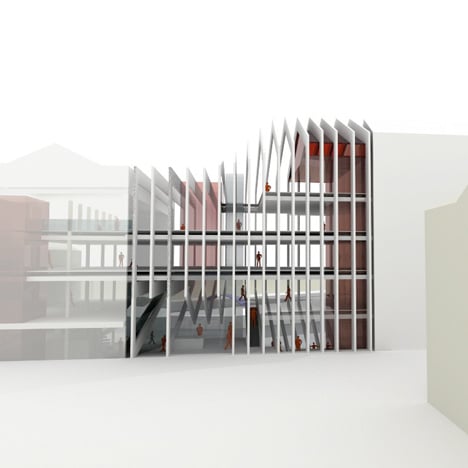 The building design aims to deliver a dramatic river front facade, utilising the expanse of the river and adjacent sheer faced wharf buildings of the south bank as a canvas. The proposal responds to the immediate vernacular, whereby the structural form continues the subtle contortion of the Calls wharf side roofscape.
The building design aims to deliver a dramatic river front facade, utilising the expanse of the river and adjacent sheer faced wharf buildings of the south bank as a canvas. The proposal responds to the immediate vernacular, whereby the structural form continues the subtle contortion of the Calls wharf side roofscape. 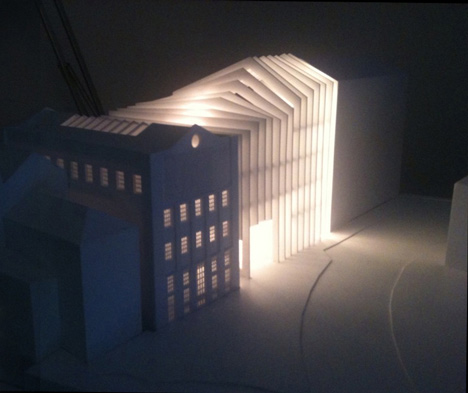 Recognising that the local area was made up of many small businesses, often in sub divided premises, the proposals seek to provide a section of the building as a local business support hub and business / social meeting space. The intention is that by providing a visual focus to the area local businesses will be able to utilize the premises for networking, entertaining and improved identity.
Recognising that the local area was made up of many small businesses, often in sub divided premises, the proposals seek to provide a section of the building as a local business support hub and business / social meeting space. The intention is that by providing a visual focus to the area local businesses will be able to utilize the premises for networking, entertaining and improved identity. 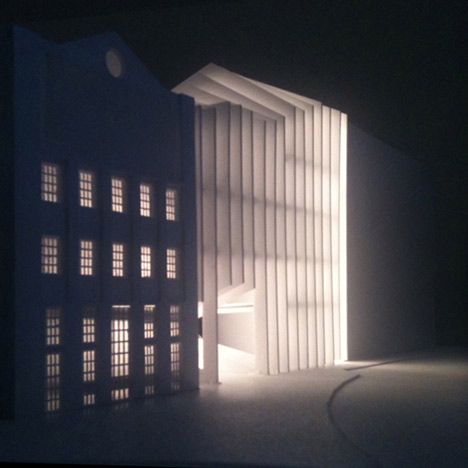 One of the key aspects of the proposal is to deliver a fantastic new public space for the city, a place that will provide extended use throughout the day beyond that of a conventional office development. In section the level changes from the street level through to riverside provide an opportunity to allow the proposed open space to be lower and therefore more immediate to the river, allowing the public to engage with and touch the water – something currently lacking with the Calls.
One of the key aspects of the proposal is to deliver a fantastic new public space for the city, a place that will provide extended use throughout the day beyond that of a conventional office development. In section the level changes from the street level through to riverside provide an opportunity to allow the proposed open space to be lower and therefore more immediate to the river, allowing the public to engage with and touch the water – something currently lacking with the Calls. 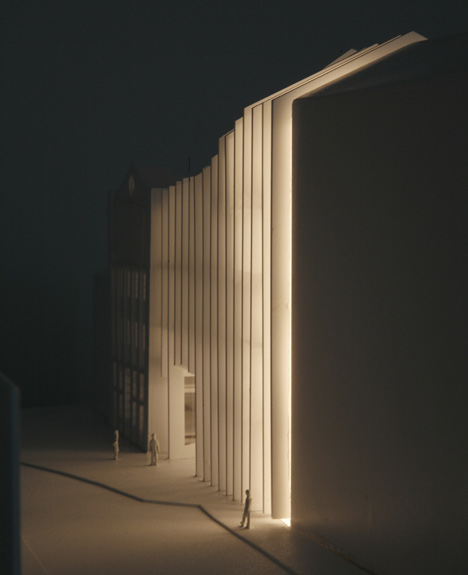 The counterpoint to the open river front is the street facade. Working from the same rigorous grid layout two very different experiences are generated by the street facade. Deep columns reach down to the ground vertically, opening up on three grid lines at the various entrances to the building and river frontage. When approaching the building obliquely along the tight historic streets of the Calls the envelope appears as a solid form, in keeping with the masonry construction prevalent to the Calls. Once upon the building the arrangement of the columns will open up to provide tantalizing glimpses of the public space and river beyond.
The counterpoint to the open river front is the street facade. Working from the same rigorous grid layout two very different experiences are generated by the street facade. Deep columns reach down to the ground vertically, opening up on three grid lines at the various entrances to the building and river frontage. When approaching the building obliquely along the tight historic streets of the Calls the envelope appears as a solid form, in keeping with the masonry construction prevalent to the Calls. Once upon the building the arrangement of the columns will open up to provide tantalizing glimpses of the public space and river beyond. 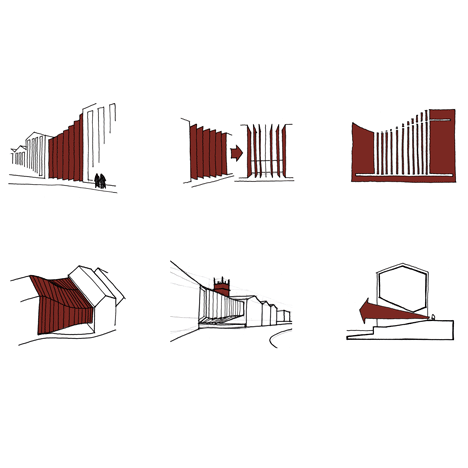 Click for larger image The proposed new public space will provide the area with a unique and distinctive meeting place for the city. It will be a place to shelter from the cold during the winter months and bask during the summertime. It will be a philanthropic gesture to the city, reflecting the numerous delightful bustling arcades that can be found in the historic shopping district. One of the delightful attributes that this external space will acquire is the play and dance of light on the under side of the river front facade delivering a true connection with the building, surroundings and the elements.
Click for larger image The proposed new public space will provide the area with a unique and distinctive meeting place for the city. It will be a place to shelter from the cold during the winter months and bask during the summertime. It will be a philanthropic gesture to the city, reflecting the numerous delightful bustling arcades that can be found in the historic shopping district. One of the delightful attributes that this external space will acquire is the play and dance of light on the under side of the river front facade delivering a true connection with the building, surroundings and the elements. 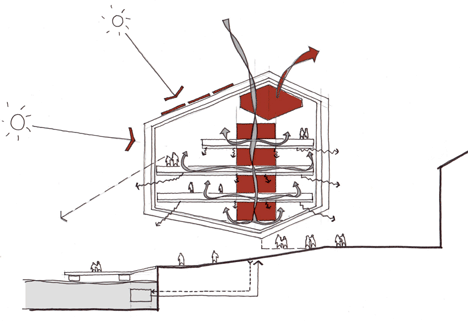 Click for larger image Internally the aesthetic is intrinsically linked to the external structure and architectural form. The columns are laid out on a typical commercial grid dimension and, because of the scale and massing of the building, you are always aware of the morphing structure. The top floors of the proposal will afford the opportunity for a fantastic contemporary space. a real synergy of structure, light and views, a combination that sets out to deliver premium office space, meeting rooms, board rooms or break-out spaces.
Click for larger image Internally the aesthetic is intrinsically linked to the external structure and architectural form. The columns are laid out on a typical commercial grid dimension and, because of the scale and massing of the building, you are always aware of the morphing structure. The top floors of the proposal will afford the opportunity for a fantastic contemporary space. a real synergy of structure, light and views, a combination that sets out to deliver premium office space, meeting rooms, board rooms or break-out spaces. 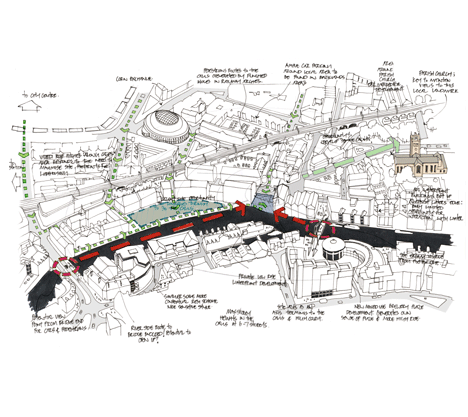 Click for larger image At the transition between the new and retained buildings the proposals adopt a light touch to preserve the integrity of the existing wharf building. Elements such as the huge signage will be retained in situ, becoming a bold part of the interior design. The construction of the extant wharf building will allow the richness of materiality to be explored and will deliver a contrast between the two sides of the development.
Click for larger image At the transition between the new and retained buildings the proposals adopt a light touch to preserve the integrity of the existing wharf building. Elements such as the huge signage will be retained in situ, becoming a bold part of the interior design. The construction of the extant wharf building will allow the richness of materiality to be explored and will deliver a contrast between the two sides of the development. 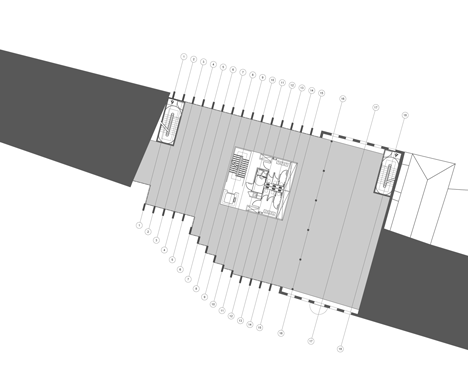 Click for larger image Concept
Click for larger image Concept
- Vertical continual street frontage, echoing the surrounding context.
- Provides a duality between solid and permeable form.
- Creates a synergy of old and new materiality.
- Morphing Form that repairs the historic urban fabric.
- Respecting local views and key city vistas.
- Provides access to the city waterfront.
Commercial Viability
- Efficient “doughnut” typical floor plates incorporating both the new build and No. 38 The Calls with one central core
- Innovative external structural solution allows for a column free office floor plate in the new building
- Multi tenant occupancy can be achieved on a floor by floor basis or by splitting the floors into two different demises
- Differing floor plate sizes (Approx. 2000sqft to 7250sqft) provide a range of letting opportunities,
- Communal core areas allow for business’ of all sizes with shared tea points, printing, meeting and reception facilities
- 1.5m planning grid for maximum flexibility
- Approx 85%+ nett internal area to gross external area ratio provided by the “doughnut” floor plate.
- Efficient Wall to floor ratio.
- Utilising one entrance for both the new and existing buildings
Sustainability
- Creating a vehicle to help make the wider business community more sustainable
- Supporting local business’ encourages the community to use local facilities and resources
- Central recycling and resource point for local business.
- Integrating environmental considerations into an innovative design solution
- Full height glazing provides a naturally lit workspace
- Structural members act as deep mullions providing natural shading and reducing solar gain and glare. The thermal mass of the exposed concrete soffits to provide passive night time cooling
- Displacement ventilation system via floor plenum with exhaust air extracted at high level.
- On site parking spaces omitted in lieu of service pull in, increased ground floor public space and cycle parking provision.
- Grey water recycling and low flow sanitary ware
- PV arrays on south facing roof.
- Canal water heat exchange
- Micro generation water turbines
Planning Viability
- Size and form knits together adjacent building heights whilst also preserving the view of the Parish Church from Leeds Bridge.
- The material of the structure utilised as a contemporary use of an industrial material linking it with the local history.
- The proposal will provide a visible platform to promote neighbourhood business’ to the wider community encouraging local providence
- Association with the business support centre would provide local business’ with a level of social, intellectual and commercial support which is otherwise restricted in an insular environment
Architectural Team: Fletcher Crane Architects: Toby Fletcher, Ian Crane and Sam Stevens Structural Engineer: Elliott Wood: Gary Elliott, George Georgiou Building Environment and Services Engineer: Skelly and Couch: Mark Skelly, Matthew Chantzidakis Quantity Surveyor: Quantem Consulting: Dan Watson Landscape Architects: Whitelaw Turkington: Ian Turkington
- Source: http://www.dezeen.com/
- milimetdesign – Where the convergence of unique creatives
































